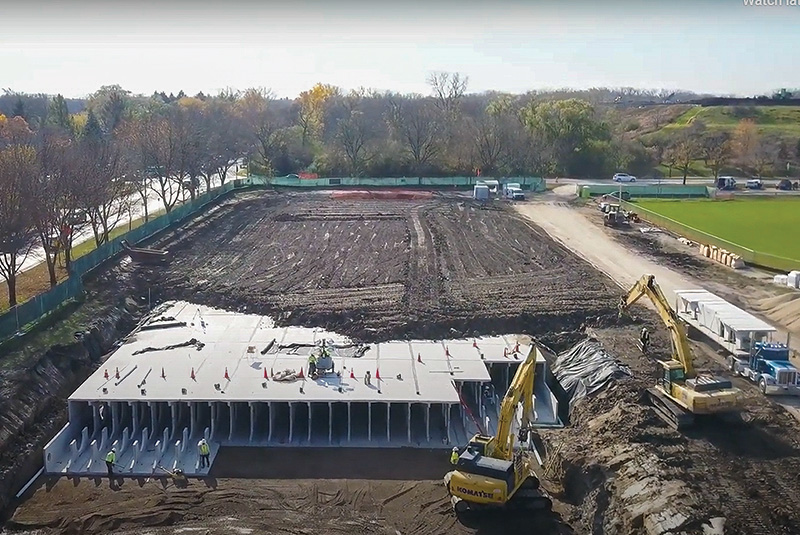
Underground cisterns as part of a larger stormwater-management project give Winnetka Golf Club about 20 acre-feet of water suitable for use in irrigation. Photo courtesy of Winnetka Golf Club
Like so many golf courses across the country, Winnetka (Ill.) Golf Club had a water problem. Unlike so many, its problem was too much of it.
“I reviewed some of the numbers,” says Andrew Garner, Winnetka GC’s director of agronomy and nine-year GCSAA member, “and the golf course would be open for half of a playable season because of too much rain. One inch of rain would have the golf course closed for maybe a week. They didn’t have continuous cart paths, and the golf course is in a low-lying area, so it wouldn’t dry out very quickly. It made it tough for maintenance.”
Heavy rains — the area had three 100-year-flood events in an eight-year span from 2008-2016 — were troublesome for more than just the course. Winnetka, a North Side Chicago village bordered to the east by Lake Michigan, had been similarly vexed, as it’s located in a lowland marsh environment and has struggled to dry out after big rains.
In 2022, the village broke ground on a $75 million intergovernmental stormwater management project that involved a water-retention/drainage system to alleviate the burdensome flooding.
A big part of the project involved installing underground cisterns adjacent to (and in one spot, directly under) the 27-hole municipal facility, as well as above-ground holding ponds. The cisterns can hold about 20 acre-feet of water (an acre-foot is 325,850 gallons, or the equivalent volume of covering 1 acre with 1 foot of water), while the ponds can hold 50 acre-feet. The stored water can be released slowly into the neighboring Skokie Lagoons or used to irrigate the golf course.
Talk about a win-win.
“From a sustainability standpoint, the golf course used to be reliant on domestic water sources,” Garner says. “With the stormwater project and our ability to retain large amounts of water and hold that until we need it, that’s given us the ability to get away from domestic water usage.”
It’s no small saving. Garner, who has been at Winnetka GC nearly three years, says previous budgets included a six-figure line item for water purchases. The abbreviated 2024 season’s water costs were next to nothing, and Garner says it probably could have been actually nothing.
The 18-hole course reopened after its renovation in August. Prior to reopening, the area was in a drought, and Garner wanted the course to look its best for the reveal.
“I had a window where I had to open the course within two weeks,” he says, “so I put a little water back in. I probably could have cut it to zero, but there was too much in the balance to sacrifice going into our opening without it looking its best.”
The project meant more to the club than just a water savings. Much of the soil dug out to make room for the cisterns and holding ponds was returned to the course.
“They had to redistribute all that dirt. All that clay was used to give our fairways a raised, undulating, positive-draining aspect,” Garner says. “The only things raised on the golf course before were tee complexes and green complexes and bunker complexes. Now, the undulation of the fairways has really created a new visual aspect, as well as positive drainage that’s really crucial to drying this property out and getting the water where it needs to be.”
Garner was pleased to learn the water was surprisingly clean, too.
“We’ve had to do a little more water-quality testing,” he says, “but we’ve come to find out the water we’re putting through the cisterns, through the water-cleaning system, is pretty darn clean and ready to be put out on the golf course. It’s not really high in nitrates or phosphorus or anything detrimental to the environment. That’s a big tip of the cap to the people who put the project together. We’re taking water from the streets and getting water that runs off from people’s yards and getting to put that water back in the environment. I’m seeing benefits on a daily basis from this project.”
In addition to the benefits to the bottom line as well as the playing experience, Garner says he has seen a few additional boosts, including decreased disease pressure.
“Overall, the drying out of this property has started to bring out a lot of wildlife,” he says. “It’s creating new habitat. I think this was a big win for the golf course. I think honestly everybody benefitted. The park district, along with the village, thought about everybody in the community and put a good product out there.
Andrew Hartsock is GCM’s editor-in-chief.